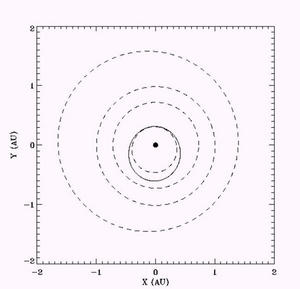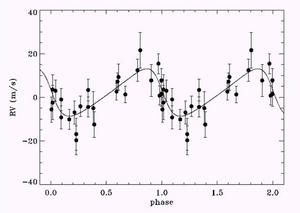An Exo-Solar planet candidate discovered by an Italian Group
The search for planets hosting life is one of the major goals of the astronomy of this century. To this purpose, the European Space Agency (ESA) and the NASA have begun long term reasearch programs. The first step is the discovery of exosolar planetary systems, and the full understanding of their formation mechanisms. However, detection of exosolar planets requires very sophisticated techniques. It was only in 1995 that a group of swiss astronomers, led by Michel Mayor and Didier Queloz announced the discovery of the first planet orbiting around a star different from the Sun. Since then, about one hundred exosolar planets have been discovered. Their often surprising charactaristics require a drastic revision of current theories of planet formation based on the knoweledge of the Solar System alone. Theorists are then eager for new discoveries in order to improve their models, and observers are competing to provide adequate data, including size, mass, and distance from the central star for a larger and larger number of planets.
Up to now, Italian astronomy was out of this important research field. However, now situation is changing. Thanks to Telescopio Nazionale Galileo, of the National Istitute for Astrophysics (INAF), operating since a few years on the island of La Palma, and of its high resolution spectrograph SARG (built by the Astronomical Observatories of Padua, Catania, Palermo, and Trieste), a group of astronomers of Padua and Catania, led by Raffaele Gratton (Padua Observatory, INAF), has found a planet candidate orbiting the star HD219542B. This the first of a hopefully long series for Italy.

|
| Figure 1 - Planet orbit compared to that of internal planets of solar system. The estimated period is 111 days. |
Silvano Desidera, a young astronomer from Padua, among the protagonists of the discovery, say:
"The planet should have the mass of Saturn, but at a distance from the star intermediate between those of Mercury and Venus from the Sun. Some caution is anyway required because this would be one of the smallest planets found so far. Further observations are in progress."
Francesco Marzari, a theoretician from Padua expert in planet formation mechanisms:
"The discovery is of particular relevance because it is a relatively small planet with respect to those observed insofar. It might be similar to the external planets of the solar system, that are made of a solid nucleus and a gaseous envelope. At the same mass, its radius should however be larger than that of Saturn, since its closeness to the star induce high temperature at the surface."
Investigations by the Gratton group are going on: since about two years about one hundred stars have been observed in order to discover orbiting planets. New exciting results are expected in the few years.

|
| Figure 2 - Radial velocity curve of HD219542B. |
The SARG Planet Search program is presented on the web page: http://www.pd.astro.it/new_sites/ESP
Further contact:
email: gratton@pd.astro.it, desidera@pd.astro.it,
claudi@pd.astro.it
phone: 049/8293442

